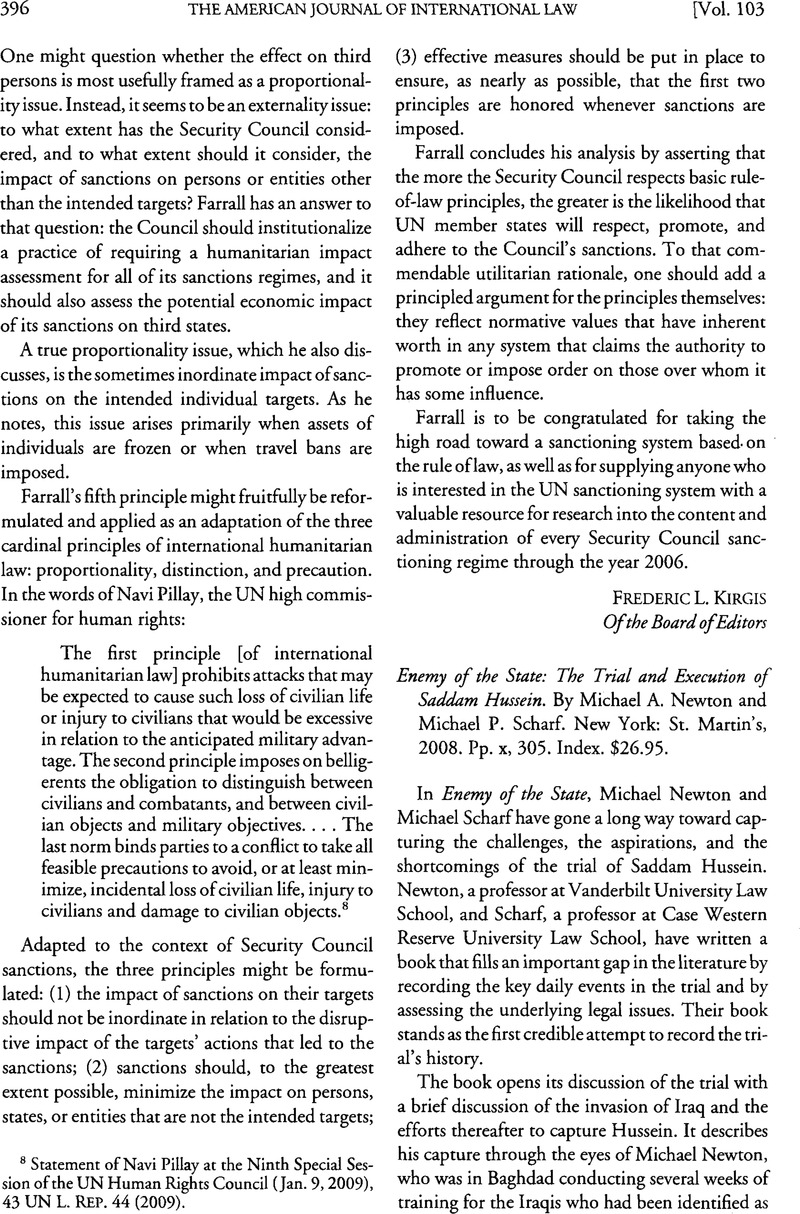No CrossRef data available.
Published online by Cambridge University Press: 27 February 2017

1 General Ricardo Sanchez, Press Conference (Dec. 16, 2003), at <http://www.defenselink.mil/mil/transcript.aspx?transcriptid=2808>; Dan Senor, Press Conference (Jan. 12, 2004), at <http://www.defenselink.mil/transcripti.aspx?transcriptid=1399>.
2 Geneva Convention [No. 3] Relative to the Treatment of Prisoners of War, Art. 13, Aug. 12, 1949, 6 UST 3316, 75 UNTS 135. The importance of credibly proving that Saddam Hussein had been captured competed against legal concerns and policy risks about using video of a prisoner of war. See Declaration of Edward R. Cummings, paras. 12–18, ACLU v. Dep’t of Defense, 389 F.Supp.2d 547 (S.D.N.Y. 2005) (No. 04 Civ, 4151 AKH).
3 See Timeline: Saddam Hussein Dujail Trial (2006), at <http://news.bbc.co.Uk/2/hi/middle_east/4507568.stm>>Google Scholar.
4 Peter J., Messitte, Common Law v. Civil Law Systems, 4 Issues of Democracy 24, 27–28 (Sept. 1999)Google Scholar.
5 See Statute of the Iraqi High Tribunal, Law No. 10 of 2005, Arts. 8(6), 18(2) (Oct. 18, 2005).
6 See id, Arts. 3(4)(B), 18(3).
7 See, e.g., Law on Criminal Proceedings with Amendments, No. 23, §172 (1971), (“If the witness does not appear . . . , the court may decide to hear testimony previously given in the written record [, and the] testimony will be treated as though it were given in front of the court.”).
8 See, e.g., id., §171 (“The court may hear the testimony of anyone who attends it and anyone who puts himself forward with information. It may summon any person to attend to deliver his testimony if it is considered that this testimony will help establish the truth”); see also James G., Apple & Robert P., Deyling, A Primer on the Civil Law System 27 (1995)Google Scholar. Relatedly, the right of cross-examination is highly circumscribed in a civil law system and preserved at both the investigative and trial stage primarily through the judges themselves and not the attorneys. See id. at 28.
9 See Law on Criminal Proceedings with Amendments, supra note 7, § 168(B).
10 See Coalition Provisional Authority Order No. 48, CPA/ORD/9 Dec 2003/48 (Dec. 10, 2003), at <http://www.iraqcoalition.org/regulations/20031210_CPAORD_48_IST_and_Appendix_A.pdf>. While empowering the Iraqi Governing Council to create the Iraqi Special Tribunal, the CPA referenced (in section 1 (1)) the extensive discussion of the statute between the CPA and the Governing Council, and explicitly required (in sections 1 (4) and 1 (5)) coordination with the CPA before establishing the elements of crimes and issuing the rules of procedure. See id., §1(1), (4), (5). Furthermore, section 2(3) stated that, during the occupation, if any conflict arose between a ruling or judgment of the Tribunal and any “promulgation of the CPA, the promulgation of the CPA shall prevail.” Id., §2(3).
11 See id., preambular para. 1.
12 See id., preambular paras. 3, 4.
13 Gregory H., Fox, The Occupation of Iraq, 36 Geo. J. Int’l Law 195, 261 (2005)Google Scholar.
14 Drafts of certain potential orders were shared with the United Nations and its special representative in Iraq, Ross Mountain, through the secretary-general’s legal adviser, Hans Corell. Mountain succeeded Sergio de Mello, the United Nations’ original special representative in Iraq, who was killed when the United Nations’ headquarters was bombed on August 19, 2003. After this bombing, the role of the special representative was radically reduced.
15 See The Statute of the Iraqi Special Tribunal—A Commentary, in Testing the Boundaries of International Humanitarian Law (Susan Carolyn, Breau & Angieszka, Jachec-Neale eds., 2006)Google Scholar.
16 See Law of Administration for the State of Iraq, Art. 26(c) (Mar. 8, 2004) [hereinafter TAL], at <http://www.cpa-iraq.org/government/TAL.html> (“The laws, regulations, orders, and directives issued by the Coalition Provisional Authority pursuant to its authority under international law shall remain in force until rescinded or amended by legislation duly enacted and having the force of law.”). Importantly, Article 15(1) of the TAL prohibited the Iraqi Interim Government from establishing any “[s]pecial or exceptional courts.” Id., Art. 15(1). As the Tribunal was originally named the Iraqi Special Tribunal, the TAL vitiated any legal challenge to the Tribunal’s establishment based upon Article 15 (1) by confirming explicitly its existence in Article 48 of the TAL. See id, Art. 48.
17 See generally Statute of the Iraqi High Tribunal, supra note 5; Iraq Const. Art. 134.
18 Bruton v. United States, 391 U.S. 123 (1968).
19 John F., Burns, Western Lawyers Say Iraq Discarded Due Process in Hussein Trial, N.Y. Times, Sept. 25, 2008, at A17 Google Scholar; see also Miranda, Sissons & Ari, Bassin, Was the Dujail Trial Fair? 5 J. Int’l Crim. Just. 272, 278 (2007)Google Scholar (stating that a judge was substituted in the “Dujail trial bench during the trial chamber’s final deliberations”).